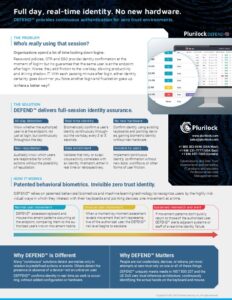Cybersecurity is an ever-evolving field, and as technology advances, so do the threats that organizations face. Traditional methods of authentication, such as passwords and biometrics, have proven to be susceptible to various attacks, leading to the need for more robust security measures. Continuous Authentication has emerged as a proactive and dynamic approach to enhance security by constantly verifying the identity of users throughout their sessions. In this deep dive, we will explore what Continuous Authentication is, why it matters in the realm of cybersecurity, and delve into its importance through an in-depth analysis.
Understanding Continuous Authentication
Definition
Continuous Authentication is a security concept that goes beyond traditional, static methods of authentication. Instead of relying solely on a single authentication event at the beginning of a session, Continuous Authentication continuously monitors and verifies the user’s identity throughout the entire duration of their interaction with a system, network, or application.
Key Components
Behavioral Biometrics
One of the fundamental aspects of Continuous Authentication is the use of behavioral biometrics. This involves analyzing and understanding the unique patterns of an individual’s behavior, such as keystroke dynamics, mouse movements, and even the way a person holds their device. By continuously assessing these behavioral biometrics, systems can create a dynamic profile of the user, allowing for ongoing verification.
Multi-Factor Authentication (MFA)
Continuous Authentication often incorporates Multi-Factor Authentication to add layers of security. Traditional MFA methods, such as receiving a one-time code on a mobile device, can be integrated seamlessly into Continuous Authentication to enhance the overall security posture.
Machine Learning and Artificial Intelligence
The implementation of machine learning (ML) and artificial intelligence (AI) is crucial in Continuous Authentication. These technologies enable systems to adapt and learn from user behavior over time, identifying anomalies and potential security threats. ML and AI algorithms can detect patterns that might indicate unauthorized access or suspicious activity, making them essential components of a robust Continuous Authentication system.
Why Continuous Authentication Matters
The Limitations of Traditional Authentication Methods
Traditional authentication methods, like passwords and static biometrics, have significant limitations. Passwords can be easily forgotten, stolen, or cracked through various means. Static biometrics, such as fingerprints or facial recognition, can be compromised if stolen or replicated.
Additionally, these methods often only verify the user’s identity at the beginning of a session, providing a window of opportunity for attackers to gain unauthorized access after the initial authentication.
Evolving Cyber Threat Landscape
As cyber threats become more sophisticated, organizations must adapt and implement advanced security measures. Cybercriminals employ various tactics, such as phishing attacks, social engineering, and malware, to compromise user credentials and gain unauthorized access. Continuous Authentication serves as a proactive defense against these evolving threats by constantly reassessing and verifying the user’s identity.
Mitigating Insider Threats
Insider threats, whether intentional or unintentional, pose a significant risk to organizations. Continuous Authentication helps mitigate these threats by monitoring user behavior for any deviations from the norm. This proactive approach enables organizations to detect and respond to suspicious activities promptly, reducing the risk of insider-driven security breaches.
Regulatory Compliance
Many industries are subject to strict regulatory frameworks that mandate the protection of sensitive data. Continuous Authentication aligns with these regulations by providing a higher level of security compared to traditional methods. Implementing robust authentication measures demonstrates a commitment to compliance, helping organizations avoid legal consequences and reputational damage.
In-Depth Analysis of Continuous Authentication
Adaptive Risk-Based Authentication
Continuous Authentication introduces the concept of adaptive risk-based authentication, where the level of security adapts based on the perceived risk level. By continuously assessing user behavior and analyzing contextual factors, such as location, time of day, and device used, systems can dynamically adjust the authentication requirements.
For example, if a user typically logs in from a specific location and suddenly attempts to access sensitive information from a different location or at an unusual time, the system may prompt for additional authentication steps. This adaptive approach ensures that the security measures align with the potential risk, enhancing both security and user experience.
Balancing Security and User Experience
One challenge in implementing Continuous Authentication is finding the right balance between security and user experience. While robust security measures are crucial, organizations must ensure that the authentication process does not create friction for users, leading to frustration and potential workarounds.
Continuous Authentication addresses this challenge by providing a seamless and unobtrusive user experience. The continuous monitoring of behavioral biometrics and contextual factors allows for passive authentication, minimizing the need for frequent and intrusive authentication prompts. This balance is essential in gaining user acceptance and ensuring the practicality of Continuous Authentication in real-world scenarios.
Integration with Identity and Access Management (IAM) Systems
Successful implementation of Continuous Authentication often requires integration with Identity and Access Management (IAM) systems. IAM systems manage user identities, access rights, and permissions within an organization. Integrating Continuous Authentication with IAM systems enhances the overall security infrastructure by combining dynamic identity verification with comprehensive access control.
Continuous Authentication, when integrated with IAM, enables organizations to enforce granular access policies based on real-time risk assessments. For example, a user attempting to access sensitive data may be subjected to additional authentication measures if the system detects anomalies in their behavior or the context of the access request.
Continuous Monitoring and Anomaly Detection
Continuous Authentication relies heavily on continuous monitoring and anomaly detection to identify suspicious activities. Machine learning algorithms play a crucial role in analyzing vast amounts of data generated by user interactions. These algorithms can identify patterns, detect anomalies, and raise alerts for potential security incidents.
Anomaly detection algorithms in Continuous Authentication learn from normal user behavior and flag deviations that may indicate unauthorized access or a compromised account. The continuous nature of this monitoring ensures that security teams can respond promptly to emerging threats, reducing the dwell time of attackers within the system.
Conclusion
Continuous Authentication represents a paradigm shift in cybersecurity by moving beyond the limitations of traditional authentication methods. Its dynamic and proactive approach provides organizations with the tools to adapt to the evolving threat landscape and mitigate risks associated with unauthorized access.
The integration of behavioral biometrics, Multi-Factor Authentication, and advanced technologies like machine learning and artificial intelligence makes Continuous Authentication a robust and effective solution. By continuously monitoring user behavior, organizations can not only enhance security but also improve the overall user experience.
As cyber threats continue to evolve, the importance of Continuous Authentication in safeguarding sensitive data and systems cannot be overstated. Organizations that embrace this innovative approach will not only strengthen their cybersecurity posture but also demonstrate a commitment to staying ahead of the curve in the ever-changing landscape of digital security. Continuous Authentication is not just a security measure; it is a strategic investment in resilience, adaptability, and long-term cybersecurity success.













